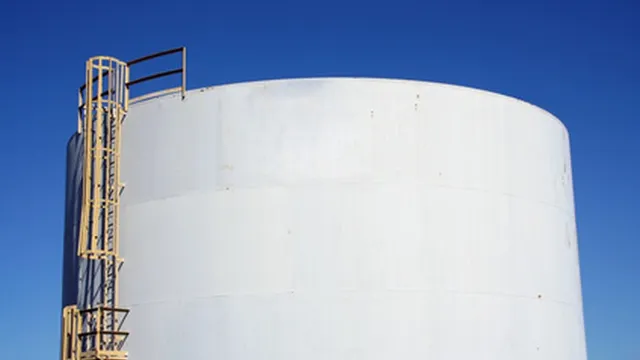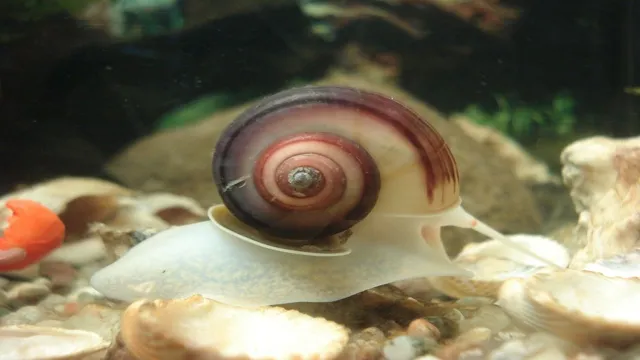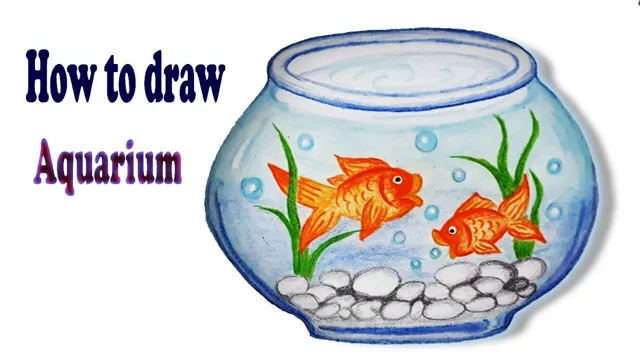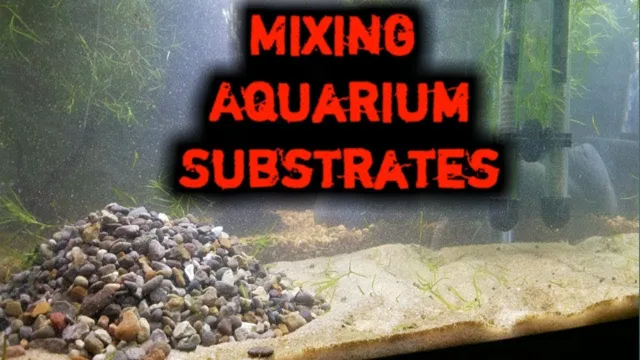Are you a new aquarium enthusiast, trying to determine the appropriate amount of water your aquarium needs? Being well-versed with the gallons of water your aquarium contains is essential for selecting the right equipment, feeding options, and species of fish, among other considerations. Without accurate knowledge, you may end up overfeeding, under-filtering, or overstocking the aquarium, leading to issues like algae blooms, fish deaths, and poor water quality. Calculating the gallons in your aquarium doesn’t have to be a daunting task.
But where do you begin? The most common method of determining the size of a fish tank is by measuring its length, width, and height. You can then input these measurements into an online calculator or use a mathematical formula to obtain the gallons. Of course, if your fish tank is irregularly shaped, determining its volume may require more sophisticated methods.
Once you’ve calculated the gallons of your aquarium, you can determine its filtration requirements, understand the appropriate stocking level for your ecosystem, and know the correct amount of water to change. Moreover, you can choose the correct heater wattage to ensure that the water is at the temperature that your fish species require. In this blog post, we’ll explain the procedures for calculating the gallons of water in your aquarium, as well as highlight the importance of accurate gallon determination for successful aquarium keeping.
Join us as we delve into the depths of determining the gallons in your aquarium, and gain confidence and knowledge as a beginner or advanced aquarium keeper.
Measuring the Length, Width, and Height of Your Aquarium
If you’re wondering how to figure out the gallons in your aquarium, you’ll need to start by measuring the length, width, and height of the tank. This will give you the volume of the tank, which you can then convert into gallons. Remember, different shapes of aquariums (rectangular, cylindrical, or irregular) will require different formulas for calculating the volume.
For example, if you have a rectangular tank, multiply the length, width, and height measurements together. Then, divide that number by 231 to get the number of gallons. Keep in mind that you should account for any decorations or substrate that may take up space in the tank, as this will affect the total volume.
With a little math, you’ll soon be able to accurately estimate how many gallons your aquarium holds.
Measure with a tape measure
When it comes to setting up your aquarium, one of the first things you need to do is measure the length, width, and height of your tank. This is essential information that will help you choose the right equipment and accessories for your aquatic environment. You can measure your aquarium easily with a tape measure, starting at one end of the tank and measuring to the other end.
Make sure you take into account any trim or framing that may be on the tank, as this will affect your measurements. Once you have your dimensions, you can start planning your aquarium setup and selecting the right filter, lighting, and other accessories to keep your fish and plants healthy and happy. So, grab your tape measure and get started on creating the perfect home for your aquatic pets!
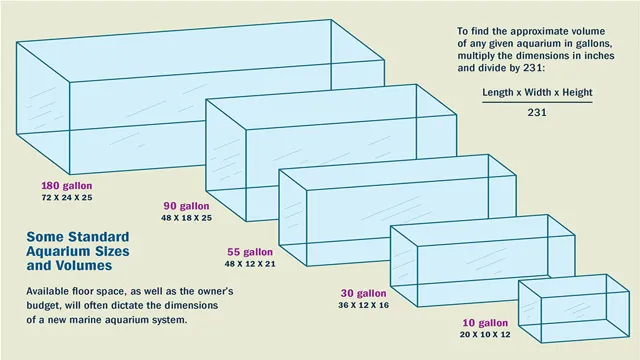
Record measurements in inches
When setting up your aquarium, it’s crucial to measure the length, width, and height accurately. To do this, you can use a ruler or measuring tape and record your measurements in inches for better accuracy. Measuring the dimensions of your tank will help you determine how much water it can hold and how many fish you can safely add.
You should start by measuring the length of your aquarium, which is the distance between its two longest points. Then, measure the width, which is the distance between its two widest points. Finally, measure the height of the aquarium, which is the distance between its top and bottom.
Once you have all these measurements in inches, you can use an aquarium volume calculator to determine the exact volume of your tank, which will help you buy the right equipment for your aquatic pets. Remember, accurate measurements are key to a successful and healthy aquarium setup. (See Also: How to Filter an Unfiltered Aquarium: A Step-by-Step Guide to Clear Water)
Converting Inches to Gallons
If you’re a fish enthusiast, you’re probably going to need to know how to figure gallons in your aquarium. It’s important to understand how much water you need to add to your aquarium to keep your fish healthy. One of the easiest ways to determine the volume of water your aquarium can hold is by converting the inches to gallons.
To do this, measure the length, width, and height of your aquarium (in inches), then simply multiply those numbers together to get the total cubic inches. Once you have the total cubic inches, divide that number by 231 (the number of cubic inches in a gallon) to get the total number of gallons your aquarium can hold. This simple calculation will help you ensure that your fish have the perfect amount of water in their home.
Use an online aquarium volume calculator or equation
When setting up an aquarium, it’s crucial to know the volume of water required to keep your fish healthy and happy. While you could try to measure the length, width, and height of the tank and manually calculate the volume, this method is prone to error. Instead, use an online aquarium volume calculator or equation to accurately determine the amount of water needed for your tank.
One important factor to consider when using these tools is converting the measurements from inches to gallons. This is because aquarium volume is typically measured in gallons, while the dimensions of your tank may be given in inches. Fortunately, most online calculators and equations allow you to input measurements in inches and will convert them to gallons for you.
By utilizing these tools and converting your measurements, you can ensure your aquarium is the ideal environment for your aquatic pets.
Equation: (Length x Width x Height) / 231 = Gallons
Converting Inches to Gallons If you’re trying to figure out how many gallons of water your pool or aquarium needs, the equation (Length x Width x Height) / 231 = Gallons can certainly come in handy. This formula allows you to convert the dimensions of your container, measured in inches, into gallons. For instance, let’s say you have a rectangular aquarium with a length of 24 inches, a width of 12 inches, and a height of 18 inches.
Using the formula, you can simply plug in the numbers and solve for gallons. In this example, you would get (24 x 12 x 18) / 231 = 180 gallons approximately.
Remember that the 231 number is the conversion factor, which represents the volume in cubic inches that makes up one gallon of water. This equation can save you a lot of time and frustration, especially if you’re dealing with an irregularly shaped container. So, whether you’re a hobbyist or a professional, this simple equation can help you convert inches to gallons accurately and easily.
Taking into Account Decorations and Equipment
If you’re wondering how to figure gallons in your aquarium, there are a few things you need to consider. First and foremost, you need to take into account any decorations and equipment in your tank, which can take up valuable space. These items can include rocks, plants, driftwood, and even air stones, all of which can affect the total volume of your tank.
To accurately calculate the number of gallons in your aquarium, you need to measure the length, width, and height of the tank, and then subtract the volume taken up by any decorations or equipment. Once you have an accurate measurement, you can use an online calculator to determine the exact number of gallons in your aquarium. Remember, it’s important to consider these factors when figuring out the size of your tank, as overstocking can lead to poor water quality and health problems for your fish.
Subtract volume of decorations and equipment from total gallons
When planning your aquarium, it’s important to take into account the decorations and equipment you’ll be using. These items can take up a significant amount of space in your tank, which can affect the overall water volume. When calculating the total volume of your aquarium, it’s essential to subtract the volume of these items to ensure accurate measurements. (See Also: How to Build an Aquarium Silicone: Step-by-Step Guide for Beginners)
This will not only help you establish the appropriate amount of water and fish that can safely live in it but also prevent any overloading of your filtration system. Typical decorations and equipment that can take up space and affect the volume of your tank include rocks, gravel, filters, heaters, and air pumps. Make sure to factor in the displacement these items will cause before determining your tank’s water volume.
By doing so, you’ll be able to create a healthy and comfortable home for your fishy friends.
Use a separate equation or table to determine volume of individual items
When calculating the volume of food items for an event, it’s important to take into account the decorations and equipment used. This may seem like added confusion, but it actually helps ensure that you have enough food for everyone and avoid any last-minute surprises. A helpful tip is to use a separate equation or table to determine the volume of individual items along with their decorations.
For example, if you’re serving cupcakes with frosting and edible glitter, the equation for the volume of the cupcake may differ from the volume of the frosting and glitter combined. Additionally, taking into account the plates, serving dishes, and utensils can help ensure that you have enough space and equipment for your food items. By being thorough in your calculations and considering all aspects of your menu, you can create a successful and enjoyable event for all.
Regularly Checking the Gallons in Your Aquarium
If you have an aquarium, it’s important to regularly check the gallons in your tank. This can help you maintain proper conditions for your fish and plants, and prevent any potential problems from arising. One way to figure out how many gallons your aquarium holds is to measure it yourself.
Start by measuring the length, width, and height of your tank in inches. Then, multiply those three numbers together to get the number of cubic inches your tank can hold. Next, divide that number by 231 to convert cubic inches to gallons.
Alternatively, you can use an online calculator to determine the gallons in your aquarium. Simply fill in the dimensions of your tank and the calculator will do the rest for you. Remember, knowing the gallons in your aquarium is essential for proper care and maintenance of your aquatic pets.
Measure gallons every few months or when significant changes are made to the tank
Regularly checking the gallons in your aquarium is an essential part of maintaining a healthy and thriving aquatic environment. Whether you’re a beginner or an experienced aquarist, understanding the importance of measuring the amount of water in your tank is crucial. One of the easiest ways to do this is by using a basic measuring cup or a digital scale.
It’s recommended that you measure your tank’s volume every few months or whenever you make significant changes to the tank’s ecosystem, like adding new plants, fish, or equipment. Consistently monitoring your water levels will help you maintain a stable environment and avoid potential problems like nutrient buildup or overstocking. Don’t forget that the more water in the tank, the more dilution there is, which is beneficial for both the fish and the plants in the tank.
By regularly measuring your aquarium’s water volume, you’ll have a clearer idea of how much water you need to change during water changes, which ultimately benefits the tank inhabitants. (See Also: How to Know if Your Aquarium Needs a Frame: A Comprehensive Guide)
Conclusion
In conclusion, figuring out how many gallons your aquarium can hold is a crucial step in creating a healthy and thriving aquatic environment for your fish friends. Remember to measure the length, width, and height of your aquarium in inches, then divide your total by 231 to convert to gallons. And if math isn’t your thing, don’t worry – with a little bit of patience and determination, you too can become a gallon-guessing guru!”
FAQs
How do I calculate the volume of my aquarium in gallons?
To calculate the volume of your aquarium in gallons, measure the length, width, and height of the tank in inches. Multiply these three numbers together and divide by 231 (the number of cubic inches in a gallon). The result will be the volume of your aquarium in gallons.
What is the average gallon capacity of a standard aquarium?
The average gallon capacity of a standard aquarium ranges between 10 and 55 gallons, but larger aquariums can hold upwards of 100 gallons.
Does the shape of an aquarium affect its gallon capacity?
Yes, the shape of an aquarium can affect its gallon capacity. For instance, a wide, shallow aquarium may have the same surface area as a tall and narrow one, but it will have a lower gallon capacity due to its shorter height.
Can I estimate the gallon capacity of my aquarium without measuring it?
While it’s always best to measure your aquarium to determine gallon capacity, you can estimate its volume by using online aquarium volume calculators. Simply input the length, width, and height of your aquarium and the calculator will determine its gallon capacity.
Is it important to know the gallon capacity of my aquarium?
Yes, knowing the gallon capacity of your aquarium is important for various reasons, such as determining the appropriate size of the filter and heater to use, as well as calculating the amount of water conditioner and medication to add to the tank.
How often should I change the water in my aquarium based on its gallon capacity?
It’s recommended to change 10-20% of the water in your aquarium every 1-2 weeks, depending on the gallon capacity. For example, a 10-gallon tank should have 1-2 gallons of water changed every 1-2 weeks.
What are the common mistakes to avoid when calculating the gallons in my aquarium?
Common mistakes to avoid when calculating the gallons in your aquarium include forgetting to convert the measurements from inches to gallons, failing to measure the water level accurately, and not accounting for rocks, decorations, or substrate that may take up space in the tank.

